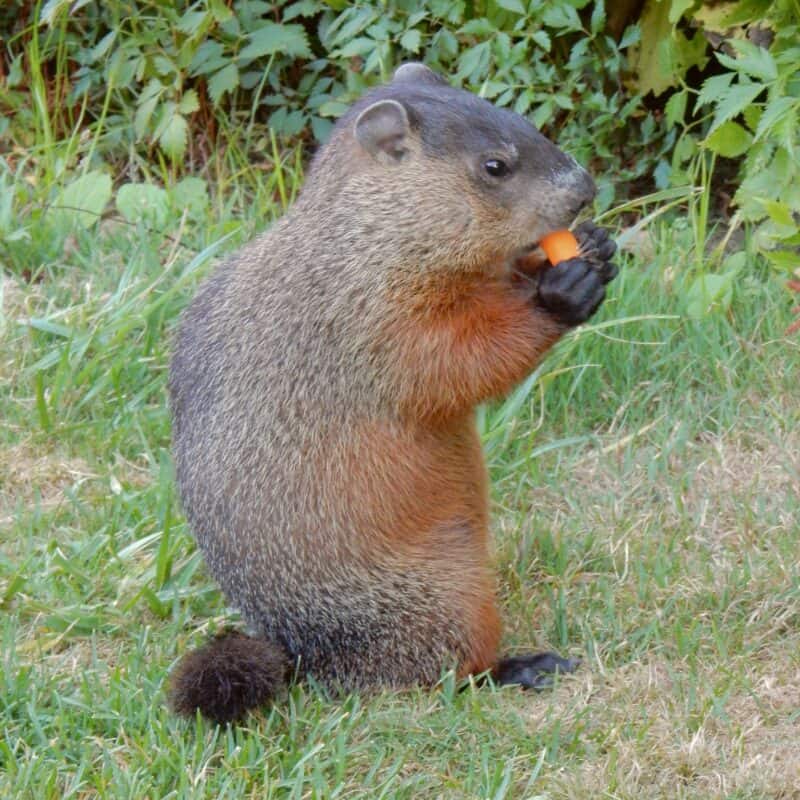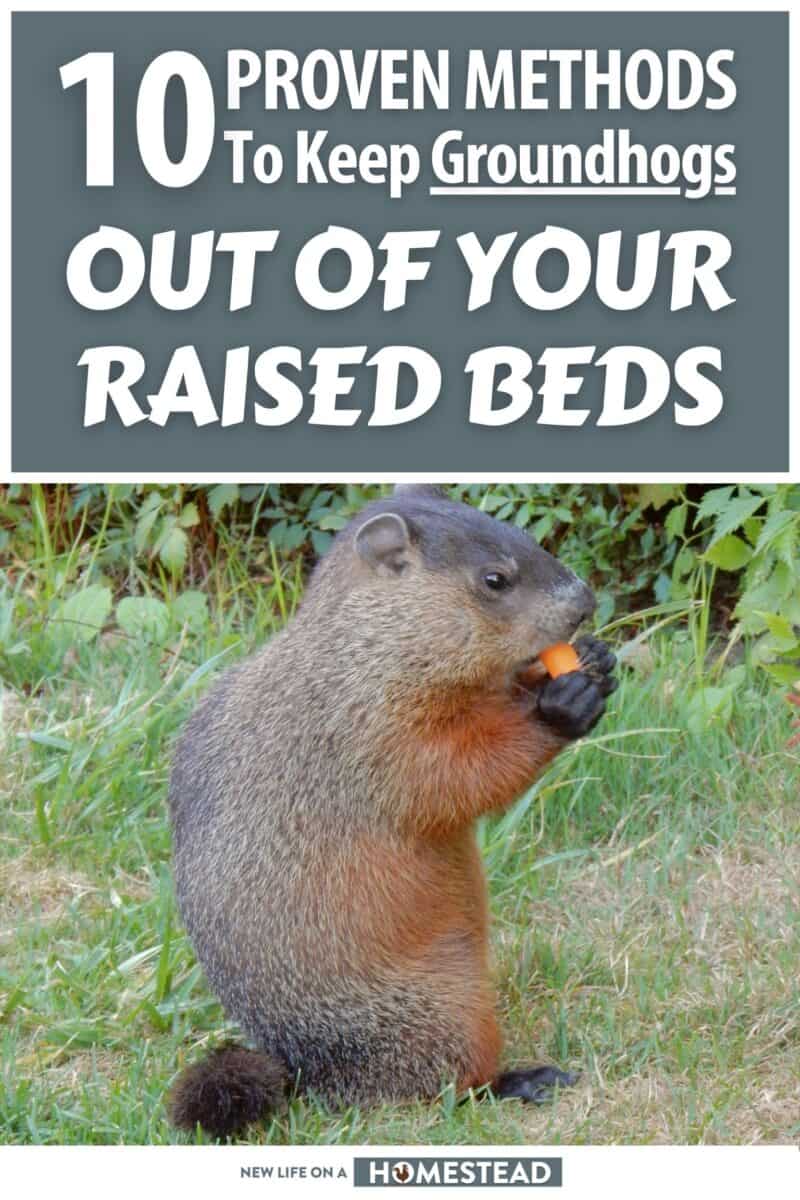If you’ve been putting in a lot of work in your garden or in your raised beds elsewhere on your property, there is hardly anything more heartbreaking than coming outside to discover pests have trampled, nibbled, and wrecked the fruits of your labor.

This is doubly true when you are closing in on harvest time!
Some of the worst offenders are groundhogs. Groundhogs are large, persistent rodents with big appetites, and they are also inquisitive and excellent diggers, making defending your beds challenging.
But, you don’t have to simply put up with them. There are lots of ways to keep groundhogs out of your raised garden beds and away from your property generally, and below I’ll be bringing you solutions that can fit any lifestyle and any budget.
1. Fill in their Burrows with Gravel and Rocks
The most straightforward and also effective method for getting rid of groundhogs is to fill in their burrows when they’re away… but not just with dirt.
You’ll want to fill it up with a combination of dirt, gravel, and larger stones, and the more you can get into the borough, the better.
The reason you want to use gravel and other stones for this purpose is because it makes it much harder, and painful, for the groundhog to dig through.
Dirt by itself will never be enough, because these little critters are master excavators.
Also, make sure you do it when the groundhog is away so it doesn’t try to dig itself out via another path, and make sure you get both entrances as typical groundhog burrows have two.
2. Use Commercial Repellents
If you don’t work that hard at eliminating or displacing groundhogs, commercially available repellents are probably the solution for you.
Groundhogs, like most rodents, have an excellent sense of smell, and there are all sorts of fragrances that they find disagreeable, offensive, or frightening.
Modern science has cooked up many solutions that intensify or even combine these effects into sprays, powders, and other concoctions that will send groundhogs heading in the other direction.
This can be a great option for some gardeners because, depending on your preferences, you might be able to use them on a perimeter basis to deter groundhogs from coming too close to your beds or your whole garden, or you can employ them strategically all over your property in order to drive groundhogs away.
Just make sure you follow the directions on the package and be prepared to reapply after it rains.
3. Try Natural Irritants
You don’t have to go with store-bought deterrents if you don’t want to. It is entirely possible to repel groundhogs with all-natural and most importantly safe things that you probably have in your home already.
A classic groundhog repellent is Epsom salt. Although it doesn’t smell like anything to us, many other mammals, including groundhogs, raccoons, and others, find it hideously offensive.
It is highly vulnerable to moisture meaning you’ll need to replace it periodically, but sprinkling some of this around your beds and near the burrow of a groundhog is likely to drive them off.
Other scents with proven efficacy as a repellent or as an irritant include castor oil, garlic, cayenne pepper, used kitty litter, and, believe it or not, lavender.
I know that most people think lavender smells wonderful, but groundhogs apparently disagree!
4. Scare them Off with Predator Scent
Groundhogs are prey animals for all sorts of predators, from larger birds of prey to felines, coyotes, and other animals.
Accordingly, they are extremely sensitive to any indicator which might tell that a predator is nearby. This certainly includes the odor of a predator.
We can use this as a sort of hack in our efforts to help drive off the groundhog by placing some predator scent near our raised beds, and near the groundhog’s burrow at both entrances.
You can also use this elsewhere on our property to form a sort of perimeter that tells the groundhogs they had better skedaddle before they get picked off.
The best predator scents to use are those of whatever predators are actually in your area. That might mean coyote urine, bobcat urine, or something else.
Most of your local well-equipped hunting stores or predator control suppliers will have this stuff, or else you can order it online.
5. Cover Your Beds
If you don’t want to unduly disturb the groundhog or just want to be triple sure that they will not proceed past a deterrent, just cover your beds.
Sturdy row covers that are secured with loops, latches or even just a good, stout frame should be more than enough to prevent a groundhog from entering the beds unless they are somehow able to tunnel under it.
If they can’t reach what’s under the cover, they will give up and go look for other food. Of course, that “other food” might be somewhere else on your property but at least your beds will be safe!
6. Fence Around the Beds
A definite step up when it comes to physical protection is simply fencing off around the beds. It doesn’t have to be a very tall fence, either, because groundhogs cannot climb particularly well.
Chicken wire or other light-duty livestock fencing is more than adequate, although I would recommend against putting your trust in plastic fencing because the powerful incisors of groundhogs can easily chew through it.
Also, you must plant the fencing at least 10 inches (25 centimeters) below the ground to prevent groundhogs from attempting to tunnel beneath it.
I cannot stress this point enough: it won’t take a groundhog any time at all to dig a nice trench or tunnel beneath your fence, and then access the goodies inside waiting just out of reach in your bed.
If you aren’t willing to sink the fencing into the ground then at least combine your above-ground fencing with a deterrent of some kind. Hopefully that will be enough to keep the critter away…
7. Soak them with Sprinklers
Groundhogs tend to be really skittish creatures, and invariably they will tuck tail and run at the first sign of trouble and it doesn’t take more than a few close calls with a predator or other disturbance to send them packing permanently looking for more peaceful habitation.
An easy, safe, harmless, and frankly hilarious way to shoo off groundhogs is by soaking them with a sprinkler or water hose.
Being startled by a blast of water is going to give them quite a fright, I promise you!
You got a couple of ways to do this: you can lie in ambush nearby with your garden hose on and ready to blast the little critter, you can have sprinklers set up to be turned on remotely or if you want to go high tech you can hook up so-called sentry sprinklers that will activate when they detect movement nearby.
Your plants probably won’t mind the extra water, anyway!
8. Trap and Relocate
Sometimes you just want the groundhog gone, and that’s all there is to it. In such a case, your best bet is to trap it and humanely relocated using a non-lethal cage trap.
These traps are widely available, reasonably affordable, and efficient, and all of them exploit a groundhog’s love of food.
All you need to do is place a juicy treat, typically a hunk of vegetable, inside the cage at the far end. Once the groundhog enters and goes for the food they will trigger the trap which will close a cage door behind it.
From here, simply relocate the animal someplace far from your home in favorable terrain where it can set up a new burrow and go on living its life.
Make sure you wear gloves when moving the cage, because groundhogs have a nasty bite!
9. Dispatch
If all else fails, you can kill the groundhog. There are several ways to do this, and they aren’t too hard to dispose of.
Whatever method you choose, always make sure you follow local laws and be safe because any kind of lethal force can hurt or kill other animals and people.
You can shoot the groundhog, use a lethal trap, poison bait, or even fumigate its burrow when it’s inside.
Sometimes there’s really no other choice, but there usually is, and even though groundhogs can be annoying and destructive, they are still an important part of the ecosystem and shouldn’t be killed out of hand.

Tom has lived and worked on farms and homesteads from the Carolinas to Kentucky and beyond. He is passionate about helping people prepare for tough times by embracing lifestyles of self-sufficiency.
